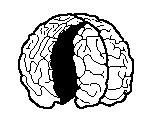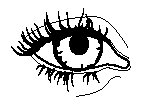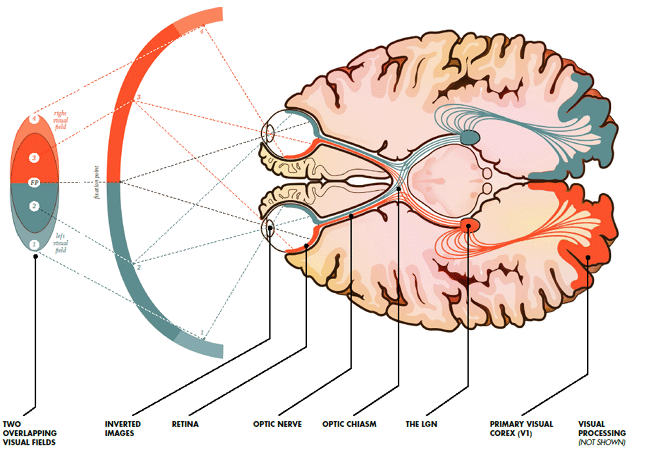Visual Perception: More Than Meets the Eye
The miraculous way our eyes capture images and how our brain processes them, which demonstrates the intricate design of the human eye
Our vision of the world merely begins at our eyes. If you could look inside your brain, you’d see a series of miracles every time you recognized something as simple as a blade of grass.
“Where’s the green snake in the grass? I can’t see it.”
If you’ve ever visited a zoo, you’ve probably experienced this frustration.
Such occasional challenges remind us just how good our eyes really are. Day in and day out, we recognize thousands of objects without thinking about it. Even when a creature’s skin color is specifically designed to thwart our prying eyes, we still can spot it—with a little extra effort.
The best computers don’t even get close to human visual perception. God uniquely designed human brains to perceive the world around us. But don’t be fooled. “Perceiving” is not as easy as it looks.
Captcha!
Modern businesses use this unmatched human ability to their advantage. They know hackers can’t write programs well enough to “perceive” numbers and letters like you and I can. So when we go online to set up an account or make a purchase, we’re frequently asked to identify strangely warped letters. Humans can easily identify the letters, but computer programs can’t.
The name for these warped images—CAPTCHA—highlights the computer’s limitations. CAPTCHA stands for a “Completely Automated Public ‘Turing Test’ to Tell Computers and Humans Apart.”
Computers and technology have come a long way. Computers can now “read” a document if they already know the font styles (optical character recognition), identify faces (facial recognition), and even respond to spoken commands (speech and voice recognition). In all of these cases, the computers are programmed to find specific patterns quickly.
But they’re still very limited. The computer relies on fast processing and piles of details stored in huge databases. Human brains don’t need this. We can easily construct a scene or a face by piecing together a few elementary clues stored in memory. The generative power of the human mind is beyond the limits of any present-day technology.

The belief that you use only 10% of your brain is a myth. You use every part of the brain.
If anything varies too much from the computer’s original parameters, it will spit out garbage. The computer may print out the letter O instead of the number 0. A voice-recognition program may write “flour” instead of “flower.” Even if a computer recognizes “Sandra O’Donnell” in a photo, it doesn’t really know who she is. It can’t smell a flower or taste the pancake made with flour. Yet our brain seamlessly integrates our vision with all of our other senses.
“Perceiving” the world is much more complicated than recognizing patterns. If the letters are too distorted or lines and other marks are added, computers easily get lost. Given the infinite number of variations, it is virtually impossible to program a computer to recognize these letters. But humans see past all the “noise” with ease.
Where It All Begins: The Eye
How does the brain process images? Perceiving the world begins with the eye. The eye is actually an extension of our brain. During early development in the womb, the brain produces two buds that soon become the eyeballs.
Creationists have long admired the eye’s design. Far superior to any manmade camera, the eye’s light-sensitive cells (photoreceptors) can adjust from direct sunlight to a single photon in pitch blackness (a range of ten billion to one). Knowing this, Charles Darwin admitted that it would be “absurd in the highest possible degree” to explain how the eye formed by natural selection. Yet he still argued that natural selection, acting on slight variations in simple eyes, could produce one that was far more complex (see “The Seeing Eye,” Answers July–September 2008, pp. 76–79).
We need eyes to see, but modern brain studies show they would be useless without the rest of the brain. Our eyes are just the first stop in a long sequence that enables us to see.

Each time you blink, your brain fills in the gaps in your vision (about 20,000 times every day).
Consider just one aspect of your vision: rich, full-color, moving 3D images. Did you realize that is not what your eyes pick up? Your eyes detect two separate two-dimensional images. Your brain must then recombine these flat images into one, steady-stream, 3D representation of the world.
To perform this miracle, your brain constantly compares the information streaming in from each eye and makes instant calculations to derive the right depth, distance, shape, color, and shading. This allows you to tell where one object ends and another begins, such as your friend and the tree behind him. With this perception you can confidently cross a busy street or swing a bat to hit a baseball.
Furthermore, the images that land on your retina are literally upside down, but the brain restores every last pixel to an upright position.
Consider another blessing of our brains. When we blink, does the world go dark? No, because the brain fills in the missing details. Our eyes don’t see this, but our brain lets us think we do.
How impressive is that?
First Stop: A Relay Station Called the LGN
To ensure you have a correct picture of the world, your brain keeps close tabs on every signal that enters your retina. Around 1.2 to 1.5 million cells, called neurons, are located at the back of each eye. Each one picks up detailed information about a different section of the visual image. Then the neurons ship the information down separate fibers, called axons, into the brain. These fibers are bundled together in the optic nerve.
The optic nerves coming from each eye meet briefly in a region called the optic chiasm. Here all the information is deliberately split into two parts of the brain. The left half of the visual field goes to the right side of the brain, while the right half goes to the left side (Figure 1).
When Upside Down Is Right Side Up
God gave us two eyes so that we could see the world in three dimensions. But to achieve the miracle of 3D vision, the two images must somehow be combined into one.
Eyes would be useless without the brain’s ability to interpret this dual visual information and combine it into one seamless image. Although some image processing takes place in the retina, most occurs in the very back of the brain, and it’s a marvel to behold.
When your eyes view a scene, the string of neurons running from the eyes to the back of your brain (the primary visual cortex) spring into action, as well as the “visual processing areas” (not shown) that are designed to interpret all this information.
If you later close your eyes and imagine the same scene, none of these neurons fire except for the visual processing areas. Amazingly, your brain enables you to still “see” the scene, even with your eyes closed!

Figure 1
Two Overlapping Visual Fields
Each eye sees slightly different scenes, which overlap. This information allows the brain to calculate the shape and distance of objects.
Inverted Images
As each image passes through the eye’s lens, it gets focused and inverted.
Retina
Each image lands on the back of the eye (the retina) upside down. Around 1.5 million neurons (nerve cells) convert this light into electrical-chemical signals.
Optic Nerve
Neurons at the back of the retina send a separate fiber (axon) down an optic nerve to the middle of the brain.
Optic Chiasm
The optic nerves meet briefly at the optic chiasm, and then half the fibers from each eye cross over. Whatever came from the left field of view goes to the right side of the brain, and whatever came from the right field of view goes the left side of the brain.
The LGN
On the way to the back of the brain, many neurons stop and connect to a small structure called the Lateral Geniculate Nucleus (LGN). The neurons connect to this relay center in a very orderly fashion. Neurons that started out next to each other in the retina end up near each other in the LGN. So far, the signals from each eye are kept separate.
Primary Visual Cortex (V1)
Neurons take the information from the LGN to the very back of the brain in the primary visual cortex. At this point, neurons from the left and right eyes are finally integrated into one image. The neurons are arranged into complex but orderly stacks, called ocular dominance columns. Each stack processes all the information from one tiny area of the original scene.
Visual Processing (Not Shown)
The neurons in the primary visual cortex send information to many other locations in the brain for further processing. One path toward the ears helps identify objects, such as human faces. The other path toward the top of the brain appears to analyze motion and the positional relationships between objects.
Sound complicated? The story gets better.
The first stop toward the back of the brain is a structure called the LGN (lateral geniculate nucleus). Here, the neurons connect in an orderly fashion. Neurons that start out next to each other in the retina end up near each other in the LGN, recreating the same topography of the retina but this time in the middle of the brain.
Input from each eye is still kept separate at this point. Another set of neurons carries the signals from the LGN to the rear of the brain, where both sides of the brain finally put this visual information back together.
Next Stop: Primary Visual Cortex (V1)
The next stop is the primary visual cortex in the back of the brain. This is the brain’s largest system, where most image processing takes place. At this point the neurons become integrated.
The neurons are arranged in stacks, called ocular dominance columns. Each stack interprets features in a tiny area of the field that the eyes see. It recognizes any changes in motion, color, or orientation.
Ocular dominance columns are not hardwired like a computer board. Instead, their configuration can change depending on use. Whatever is used heavily gets more connections, and whatever is idle gets reassigned.
A baseball player who practices hitting fast balls, for example, is assigned more and more neurons to detect the ball’s quick motion. Idleness has the opposite effect. Experiments have shown that if one eye of a newborn kitten is covered, all the neurons in the primary visual cortex will be reassigned to the other eye, and the cat will become permanently blind in that eye.
The primary visual cortex is just another step in the brain’s making sense of the visual puzzle. The stacks can recognize things like dark green pixels or vertical lines, but that’s not the same as identifying blades of grass and slithering snakes. That takes several more steps.
Last Stop: Visual processing
From the back of the brain, neurons spread to various locations to perform other critical processes. Some neurons respond to color and others to motion. In turn, these visual processing areas connect to “association areas” where the brain finally puts everything together into a complete package—the colors and lines turn into snakes slithering through grass.

A small area in the brain, called the amygdala, enables you to read faces for clues about emotions.
Several additional systems are involved before you reach the “Aha! I see the snake!” moment of visual processing. One system, which follows a path of neurons toward the ears, creates high-resolution images and helps us identify objects such as snakes and grass. Another system, which follows a path toward the top of the brain, appears to recognize spatial relationships. For example, it helps detect the motion of snakes and their position relative to other objects (and the viewer).
Visual perception may be the end of the quest to find the snake, but it is not the end of the brain’s activity. For instance, the brain may associate the snake with deep emotions, such as a desire to recoil or run away in fear.
Our brain is always active, even when our eyes are closed or when they go blind. Our eyes merely supply our brains with additional information that God wants us to put into action, praising Him for His works and pointing others to Him.
Evidence of the Creator
When we first look at a scene, the neurons fire up all along our visual system. If we later remember that scene and describe it to others, most of those neurons are idle. Only the higher visual processing areas remain active. We don’t need the primary visual cortex to think or even to visualize. Vision is just one of many tools that God has put at our brain’s disposal.
God wants us to be careful where we focus our eyes (see Job 31:1; Psalm 101:3; and Psalm 119:37). Once we possess images from the world, more important tasks begin—remembering, weighing options, making wise decisions, and helping others understand the truth. All these tasks are meant to glorify God (1 Corinthians 10:31).
Perhaps that helps explain what Jesus Christ meant when He said, “Seeing you will see and not perceive” (Matthew 13:14). God expects us to find the deeper spiritual significance behind physical things we see. We’re not really “seeing,” as God intended, without the light of His Word (Psalm 19:8). Our physical world is just a window into a grander reality that transcends the physical universe.
We now know that vision is infinitely more complex than Darwin ever imagined.
Even in the smallest details of vision, our Creator is “clearly seen, being
understood by the things that are made
” (Romans 1:20).
Answers Magazine
July – September 2013
To say that the human brain is more amazing than a computer misses the point. We now know that it’s nothing like a computer— and far more powerful! In this issue of Answers you’ll learn why a computer will never match the human brain. Also, discover why the big bang is a theory in crisis, what the Bible says about women in combat, and much more!
Browse Issue
Answers in Genesis is an apologetics ministry, dedicated to helping Christians defend their faith and proclaim the good news of Jesus Christ.
- Customer Service 800.778.3390
- Available Monday–Friday | 9 AM–5 PM ET
- © 2025 Answers in Genesis




